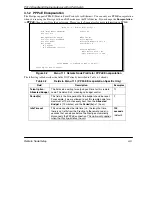
P314 Broadband Sharing Gateway with 4-Port Switch
Internet Access
3-3
3.1.5 DHCP
Configuration
DHCP (Dynamic Host Configuration Protocol, RFC 2131 and RFC 2132) allows the individual clients
(workstations) to obtain the TCP/IP configuration at start-up from a server
.
You can configure the Prestige as
a DHCP server or disable it. When configured as a server, the Prestige provides the TCP/IP configuration for
the clients. If set to
None
, DHCP service will be disabled and you must have another DHCP sever on your
LAN, or else the workstation must be manually configured.
IP Pool Setup
The Prestige is pre-configured with a pool of 32 IP addresses starting from 192.168.1.33 to 192.168.1.64.
This configuration leaves 31 IP addresses (excluding the Prestige itself) in the lower range for other server
machines, e.g., server for mail, FTP, telnet, web, etc., that you may have.
DNS Server Address
DNS (Domain Name System) is for mapping a domain name to its corresponding IP address and vice versa,
e.g., the IP address of
www.zyxel.com
is 204.217.0.2. The DNS server is extremely important because
without it, you must know the IP address of a machine before you can access it.
There are two ways that an ISP disseminates the DNS server addresses. The first is for an ISP to tell a
customer the DNS server addresses, usually in the form of an information sheet, when you sign up. If your
ISP does give you the DNS server addresses, enter them in the
DNS Server
fields in
DHCP Setup.
The
second is to leave this field blank, i.e., 0.0.0.0 – in this case the Prestige acts as a DNS proxy.
Example Of Network Properties For LAN Servers With Fixed IP#:
Choose an IP:
192.168.1.2 – 192.168.1.32
;
192.168.1.65 - 192.168.1.254.
Netmask:
255.255.255.0
Gateway (or default route):
192.168.1.1 (Prestige LAN IP)
DNS server:
192.168.1.1
Domain:
(optional)
3.1.6 IP
Multicast
Traditionally, IP packets are transmitted in one of either two ways - Unicast (1 sender – 1 recipient) or
Broadcast (1 sender – everybody on the network). Multicast is a third way to deliver IP packets to
a group
of
hosts on the network - not everybody.
IGMP (Internet Group Multicast Protocol) is a session-layer protocol used to establish membership in a
Multicast group - it is not used to carry user data. IGMP version 2 (RFC 2236) is an improvement over
version 1 (RFC 1112) but IGMP version 1 is still in wide use. If you would like to read more detailed
information about interoperability between IGMP version 2 and version 1, please see sections 4 and 5 of
RFC 2236. The class D IP address is used to identify host groups and can be in the range 224.0.0.0 to
239.255.255.255. The address 224.0.0.0 is not assigned to any group and is used by IP multicast computers.
The address 224.0.0.1 is used for query messages and is assigned to the permanent group of all IP hosts
















































